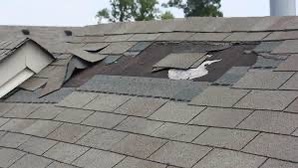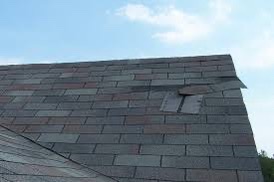If you’re like most people, you probably don’t know how to tell if your roof has been damaged by high winds, or when you’ll need your roof replaced as a result. It’s not always easy to see the damage from the ground, and sometimes it can be difficult to determine whether or not the wind was actually responsible. Even when a storm produces no rain or hail, your roof can still sustain damage. Strong winds can create stress points on a roof that, over time, can weaken and become compromised. While roofs are designed to resist typical wind loads, they can be incrementally damaged over the years by high winds and debris carried by the wind. The following will provide tips on how to inspect your roof for wind damage, and examples of what it could look like.
- Composition Shingles – Curling, loss of granulation, broken, damaged or missing shingles
- Wood Shingles/Shakes – Mold or decay, splitting or curling
- Flat Roof – Obvious patches, cracks or tears, several blisters and/or wrinkles (also check patched areas from inside the attic)
- Flashing – Tears, buckling around roof penetrations
- Roofing Cement: Excess cement, crumbling
- Soffits and Fascia – Decay, stains
- Soffit and Ridge Vents – Clogged or damaged vents, flashing and shingles around them curling or missing
- Gutters – Decay or rust, leaky seams, loosely attached to the structure, bent or sagging, missing sections of gutter or downspout, filled with debris. Clogged gutters can easily freeze shut and cause excessive weight on gutter fasteners, ice dam conditions, and slippery walks below
- Chimneys – Leaning, loose or missing flashing, damaged bricks, cap or cracked joints. Chimney flashing is especially prone to tearing because a chimney settles independently from the house
While you can’t control the weather, there are a few things you can do to help protect your home against wind damage:
- Keep trees well-trimmed and away from your house. This will help prevent branches from falling on your roof in high winds
- Secure outdoor furniture and other loose items. If you have any lawn chairs, grills, or other outdoor items, make sure they’re securely fastened so they don’t blow away and damage your property. Install hurricane shutters or impact-resistant windows
- If you live in an area that experiences hurricanes or severe weather regularly, invest in some hurricane shutters or impact-resistant windows. These can help protect your home from debris and wind damage
- Reinforce your garage doors. If your garage doors are old or damaged, they might not be able to withstand high winds. You can reinforce them by adding additional bracing or installing a wind-resistant garage door
- Check your roof regularly. Inspecting your roof for damage and making repairs as needed can help uphold its integrity and keep it in tip-top shape to protect
- Invest in wind-resistant shingles such as those that have been tested to withstand high winds. These shingles can help protect your roof against wind damage, even if a severe storm does come through
If you do experience wind damage to your roof, it’s important to work with a reputable roofing contractor to make the necessary repairs. A professional roofer will be able to assess the damage and make sure all of the repairs are made correctly so your roof can protect your home for years to come.
Have questions? Call Classic Roofing & Gutters at 770-424-2010
or email us at info@classicroofing.com
Wind Damage
Deprecated: File Theme without footer.php is deprecated since version 3.0.0 with no alternative available. Please include a footer.php template in your theme. in /var/www/wp-includes/functions.php on line 6085
Classic Roofing & Gutters is proudly powered by WordPress

